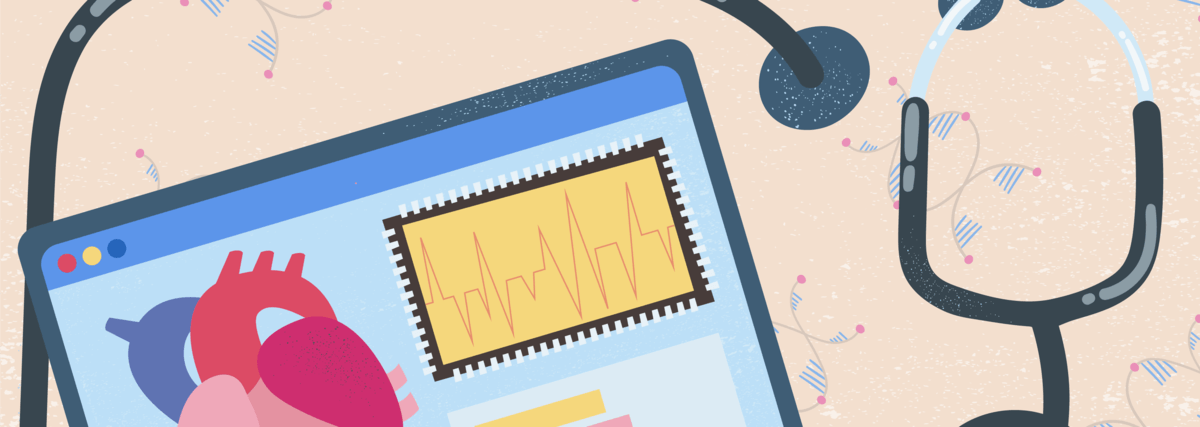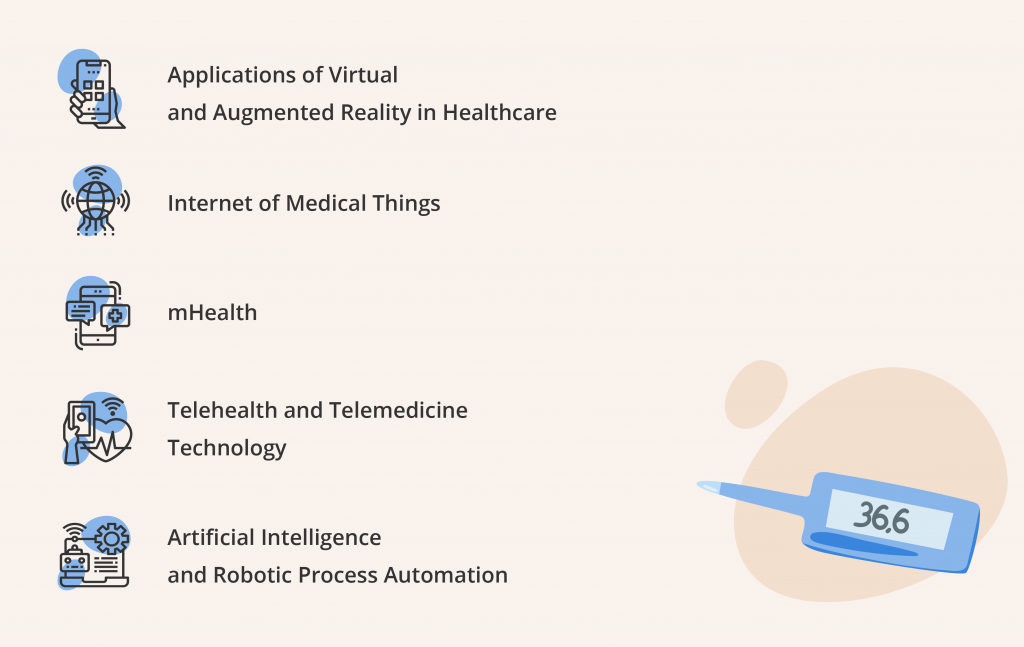An Overview of Modern Technology in the Healthcare Industry

After covering the benefits of implementing computer technologies in the areas of education, travel, and recently, commerce, we dedicate this post to the growing role of technology in the medical field.
The market of digital healthcare is growing rapidly. It was valued at approximately US$88 billion in 2018 and is expected to exceed US$500 billion by 2025. Over the past decade, the digital health industry funding all over the world has grown almost twenty times. These numbers may be evidence of the profound positive impact of technology in the healthcare industry.
As patients are requiring more progressive solutions and higher quality of services, healthcare providers are looking for innovations to stay relevant and enhance business operations. To this end, many people will benefit from the increasing adoption of Virtual and Augmented Reality (VR and AR), mHealth, Telehealth, the Internet of Medical Things (IoMT), Artificial Intelligence (AI), and other emerging technology in the healthcare industry.
How is technology relevant during the current COVID-19 pandemic? What does mHealth stand for? What are the benefits of utilizing telemedicine? This article should provide the answers to these and other questions.
Main Trends in Employing New Technology in the Healthcare Industry

Applications of Virtual and Augmented Reality in Healthcare
Virtual reality is a completely simulated environment created by headsets and software, whereas augmented reality only superimposes computer-generated objects on the environment seen through a special lens or screen.
The primary use of augmented reality in medicine and training is the visualization of parts of a patient’s organism and other objects that are normally invisible to the human eye.
Augmented reality medical applications also assist in:
- training future surgeons
- health condition assessment
- treatment planning
- clarifying complex medical subjects to patients
Virtual reality can be used for:
- treatment of mental health conditions and psychological therapy
- reducing pain during medical procedures
- increasing patient engagement during physical therapy and speeding up recovery
- raising disease awareness
Internet of Medical Things
The Internet of Medical Things (IoMT) is all about creating smart systems of medical devices and healthcare applications that facilitate the provision of better services and improve the workflow of medical units. Simple use cases are devices such as healthcare trackers, wearables, and sensors quickly sending patients’ health data to doctors without patients actually visiting the hospital.
The development of IoMT offers opportunities to:
- monitor patients at home or on the go from anywhere, measuring and tracking critical health indicators
- create personal treatment programs based on the collected data
- actually save lives over time
- optimize workflows within hospitals and clinics
The IoMT market size is expected to reach US$254.2 billion by 2026, a significant increase compared to US$44.5 billion in 2018, a natural result of the massive adoption of information technology and healthcare industry’s rapid development.
mHealth
What is mHealth? This abbreviation for mobile health refers to the practice of medicine or public health supported by mobile devices.
This industry is rapidly developing. In 2018, its total revenues nearly reached US$28 billion worldwide; this amount is predicted to increase over 8 fold by 2025.
The primary group of users is chronically ill people who require the constant tracking of health indicators, but the benefits of mHealth technologies extend far beyond that. For example, at the height of the COVID-19 pandemic, many countries saw hikes in medical app downloads.
Telehealth and Telemedicine Technology
Also around the pandemic peak, telehealth claims across the US increased over 4,000%. (What is telehealth? This rather broad notion encompasses remote non-clinical services, such as health personnel education services or remote monitoring of vital signs.)
What is telemedicine then? This term refers to using telecommunication technology for medical diagnosis, treatment, intervention, and monitoring. Online doctor consultations and self-diagnosis applications are just a few examples.
The main benefits of any telehealth or telemedicine system for patients and doctors are saving precious time for travel, especially in rural areas and urgent situations, and automated communication with healthcare units.

Artificial Intelligence and Robotic Process Automation
Artificial Intelligence (AI) has the potential to enhance the workflows of various industries, but how does technology help the medical field? For example, AI played an important role in dealing with the COVID-19 outbreak. Particularly, AI helped doctors to better understand the virus, slow down its rapid spreading, and screen the molecules to create a treatment plan.
In the US alone, using AI in key clinical applications can save up to US$150 billion in annual savings by 2026.
Firstly, robotic process automation utilizes the power of AI to enhance the operational workflows of medical organizations.
Secondly, AI technology changed healthcare by facilitating mining medical records and effectively analyzing massive data sets. By predicting possible patient outcomes, the technology can help define the best treatment plan for specific patients.
AI is already integrated into caregiving and nursing as it simplifies analyzing the health situation, creating a treatment plan, serving the meals, etc. It is also implemented in chatbots, virtual health assistants, robot-assisted surgery, precision medicine, medical dosage, diagnosis, healthcare units workflow optimization, cybersecurity, and more.
Portable Scanning Devices
One of the big dreams of healthcare professionals and laypeople is to have a powerful tool that can help diagnose and analyze almost any disease. This dream is gradually materializing in the shape of portable health scanning devices.
For example, Viacom’s devices can measure the heart rate, blood oxygen saturation and glucose, body temperature, and other body indicators. BioSticker by BioIntelliSense goes even further by monitoring body position, gait, activity levels, sleep, coughing, and more, despite its tiny size. Neither can be compared to the tricorder from Star Trek yet, but the speed at which technology in healthcare is evolving may bring us there quite soon.
Conclusion
Now you know more about how technology is changing healthcare services for the patients and helping organizations become more agile with their operations, reducing costs and increasing revenues.
Various wearable and portable health monitoring devices, relevant web and mobile applications, and innovative solutions enhanced by immersive experiences and artificial intelligence are only a few examples of the impact of medical technology on healthcare today.
If you want to join the digital revolution and look for a team equally passionate about healthcare and technology, please don’t hesitate to contact Alternative-spaces. Our experienced programmers, designers, and project managers know how to take your business to the next level.
Content created by our partner, Onix-systems.
 Home
Home